11 Tips for Candid Street Photography
Candid street photography, or candid portraits, can be some of the most interesting photos captured in everyday places. Heading out into the crowd with a camera is exhilarating and intimidating at the same time. Great photographic scenes play out on the streets right before your very eyes, but people are quick to recognize the camera and ruin the opportunity. Being covert without being creepy — it's all part of the game we call street photography (and quite different from traditional portrait photography).
DISCLAIMER: I'm not suggesting that anything and everything is either legal or moral in street photography situations. Know the laws and use your best judgment. For further reading on the subject, see this Wikipedia article on Street Photography.
I know this is a debated topic among photographers, but the point of this article isn't to start an argument about the rights and wrongs of candid portraits. The point of this article is to introduce some tips and techniques with example photos for those interested in this style of photography — this is by no means a complete guide to street photography. So here we go…
1. USE A LONG LENS
If you want a good candid, keep a bit of distance from the subject. Once people are aware of your camera, they're likely to pay more attention and your chances of getting a true candid go down. I'm not saying you should roll around with a 400mm lens, but anything under 85mm or 100mm is going to be fairly close-range. This one was taken with a 105mm on a 1.5x crop sensor — so about 160mm equiv.
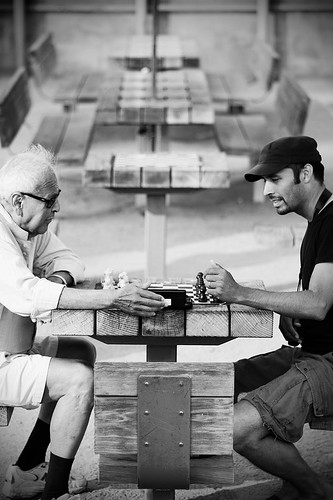
2. SNEAK UP FROM BEHIND
Obviously it's harder to get a candid shot from the front than from behind, but sometimes you have to take what you can get. If you like the scene and your subject is staring off into the distance, take a shot. Sometimes getting a shot without the face can add a bit of mystery to the photo too.
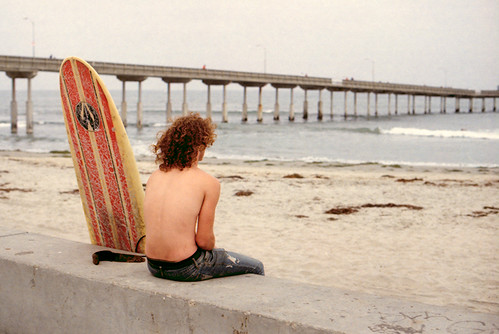
3. WATCH THE BENCHES
The hard part of catching a candid portrait is that people are moving, things are passing in front of your view, and your window of opportunity passes quickly. People generally sit on benches, which means they're not moving around too much and they might be there for more than 5 seconds. Look for the subjects that are focused on some task, such as feeding birds or reading a paper.
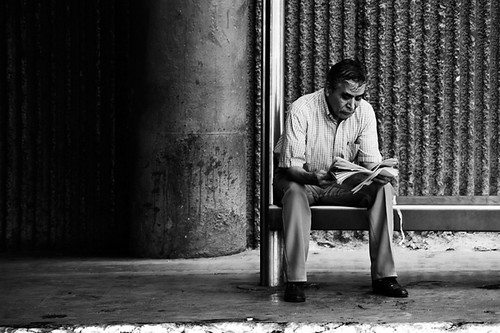
4. KEEP YOUR EARS OPEN
Your eyes are your primary sensor for photography, but keep your ears open too — especially when your face is pressed up against the back of the camera. You can often hear opportunities coming your way, sometimes before you can even see them.
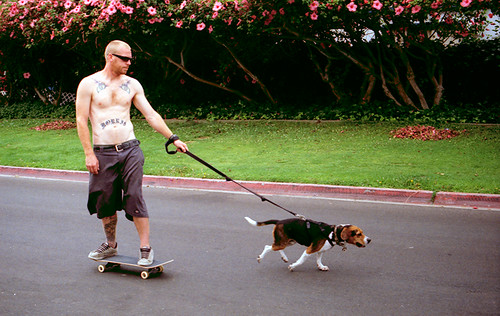
5. SHOOT THE PERFORMERS
Street performers are great fun to photograph. They expect that people will take their photo during the performance, so you need not worry about ticking them off. Plus, they're usually good characters and make for great portraits. Just don't forget to throw a few bucks their way — they aren't usually out there for the pure fun of it.
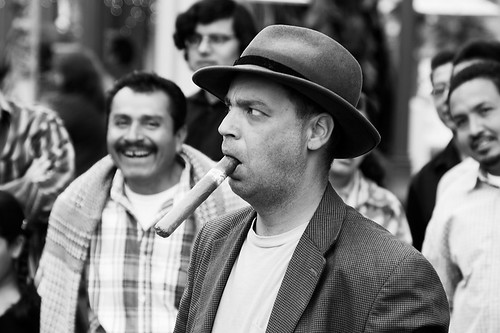
6. FIND GROUP GATHERINGS
If you see a group of people congregating for whatever reason, this is a good chance to mix with the crowd and get up close for some candids. Gatherings can take many forms: drum circles (shown below), protests, rallies, parades, etc.
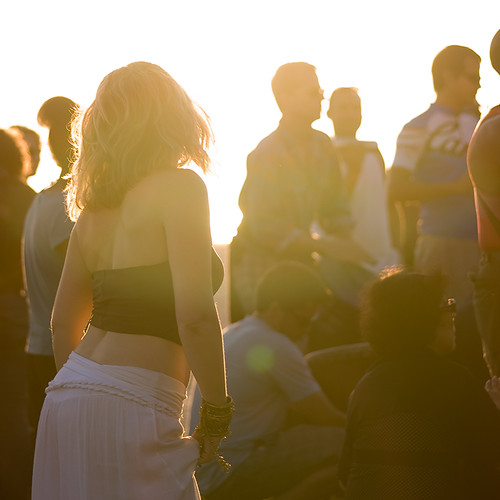
7. DON'T FORGET THE BACKGROUND
A lot of times it's hard enough to get a good candid shot of the subject, so worrying about the background seems secondary. But if you find a good strong background, get the composition all set up and wait for the subjects to enter the scene.
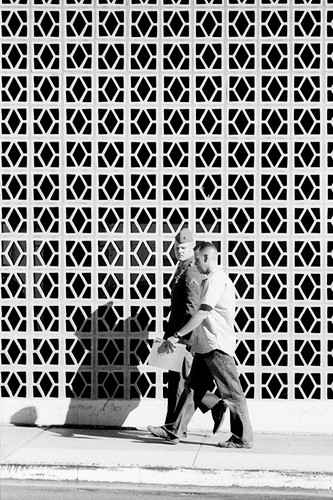
8. GET OFF THE STREETS
Street photography doesn't necessarily have to be done on the streets. Any place where there are people, there will be an opportunity for some candid portraits. So things like public buildings, beaches, parks, etc.
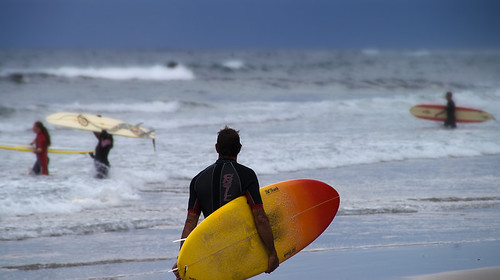
9. FIND A SPOT AND WAIT
I've used this technique from time to time with good results. Find a spot that you like — something with an interesting composition, pattern, or background. Now envision somebody in that scene as you'd like to take the photo. Get all set up… and wait for it. Somebody will eventually walk into the scene and you'll get your shot.
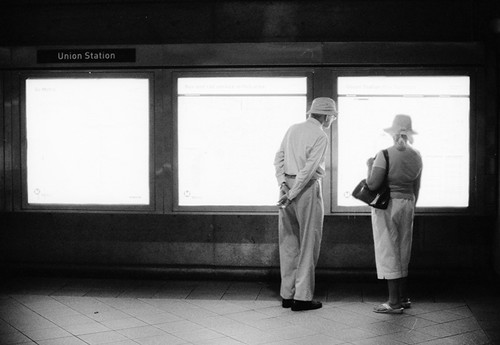
10. USE A WIDE LENS
Not all portraits need to be up-close and personal. Use a wide lens from time to time and capture more of the surroundings than the person — but use the person as an anchor for the composition.
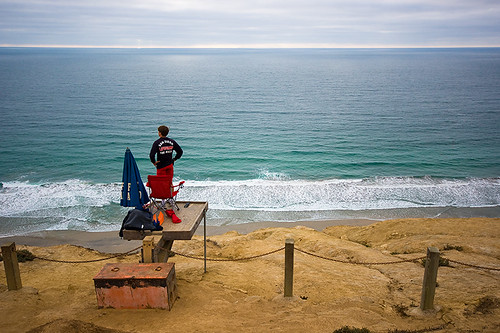
11. SOMETIMES YOU JUST GET CAUGHT…
If you're going to take candid photos of people on the streets, be prepared to get caught. Also be prepared for anything from a friendly conversation to unfriendly confrontation to physical assault. All I'm saying is be mindful.
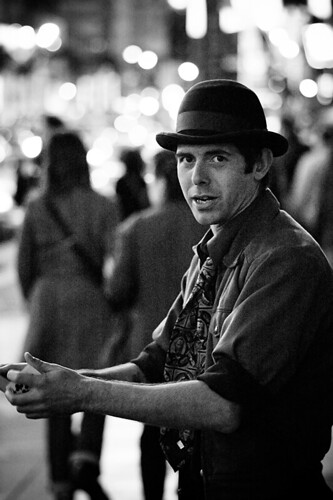
I'm interested to hear from all of you on this topic. Leave a comment and/or tip in the comments below… maybe we can pull together another follow-up article full of tips and photos from the readers.
inspirationbit
April 29, 2009great perspectives. Just curious: have you ever been unfriendly confronted when shooting other people on the street, and if yes, how did you handle it?
I sometimes want to shoot strangers, but scared that they might take it the wrong way, so yes, the long lenses are good for that purpose. Shooting from the back and the crowd is harmless as well 😉
Mike Bridge
April 29, 2009I’m not convinced by #1. My feeling is that using a long lens like this on the street usually disengages the viewer. Using a 35 or 28mm up close gives you more of what a person naturally sees, and so it makes the photo seem more like you’re really standing there—it’s not a tiny rectangle enlarged from a block away.
I agree with 6 through 11, but it’s pretty hard to make street performers, people reading, or the backs of people’s heads into good street photographs unless you have something else really compelling going on in the shot.
Brian Auer
April 29, 2009Yup, a long lens tends to remove the photographer from the scene, but not everybody can work up the guts to shoot up close with a 28mm lens. Long lenses are a good place to start, get comfortable with shooting candidly, and build confidence.
Jeremy Brooks
April 29, 2009Good tips. I think the long lens is a valid option; sometimes you cannot get close to the things you want to capture without changing the scene.
Brian Auer
April 29, 2009@Jeremy Indeed, the scene of the two men playing chess wouldn’t have been captured if I walked right up to them to get the shot. There was nobody else around and I would’ve been completely obvious.
@inspirationbit I’ve had pretty good luck with staying out of trouble. I get the occasional dirty looks and “what are you doing?” comments, but never had anybody come after me. There was one time on Venice Beach that I took a photo of a guy’s dog and he totally flipped out on me. I was actually a bit scared because the dog was a pit bull and the owner was a belligerent a-hole. I got out of there quickly.
Janne
April 30, 2009To me the best way to get comfortable is to be semi-obvious. Unhurried, with a camera in plain view, setting things up, hanging in one place and very much not hide and especially not rush at all.
What happens is everyone is sort-of aware that you’re there with a camera. Anybody who really doesn’t want their shot taken has plenty of time to move aside, or just turn away. When people do, I accept it and move on – I have no wish to make anyone irritated or upset just for the sake of a shot. The people that don’t move away accept that I’m there and that I may be taking their image.
Also, people can only stick with their unnatural “camera poses” for moments at a time before things happen around them and they forget all about puffing themselves up for the camera. That’s another benefit of being slow; you get natural shots quite easily.
Mike Bridge
April 30, 2009I had a rare confrontation with a Really Angry Person yesterday. I was taking a shot of a group of commuters walking through some reflected light on their way to work downtown, so I wasn’t even singling him out—he just walked into my frame. He marched over and demanded that I give him the “film”. I told him I was shooting digital and would he happy to delete it if he wanted. He started swearing and saying how he had an “important job” which I was somehow jeopardizing, and proceeded to scream every conceivable grievance that came into his head. I graciously apologized and left, but he came back later, still seething, demanding the “model number” and serial number of my camera (intending to do what with it, I don’t know).
That’s the only thing that really concerns me on the street—the people who are mentally unstable. I always explain what I’m doing honestly, and that almost always satisfies people. Usually they’re just curious, since street photography is unheard of where I live. But the mentally unstable people who can’t be reasoned with are a little more frightening. I very rarely take pictures of people who are down-and-out on purpose for a number of reasons, but that’s the primary one.
Anyway, I agree with @Janne—the best way to blend in is to act like you’re supposed to be there taking pictures. Don’t furtively snap away like you’re trying not to get caught, because people will assume you’re doing something wrong. Walk up, take the photo naturally and confidently, smile afterward if necessary, be gracious if asked for an explanation, and people will assume that whatever you’re doing is probably OK.
Joanie
April 30, 2009Long lenses can add a sense of the distance we have between us as human beings. We can all be crammed into one place, but the actual distance emotionally is sometimes wonderfully captured with a longer lens. Other times, you capture a moment that is completely spontaneous that you couldn’t get otherwise.
Regarding “getting caught”: the Silver Man on Adams Avenue is a great example of someone who does NOT want his photo taken, unless you compensate him. I was walking down the street last year during Street Fair and saw him. As I was setting up the shot, he noticed me and turned away. Every time. He watched like a hawk. There’s no hiding from him. But I did get one photo eventually. If he hadn’t been so grumpy, I probably would have considered dropping a couple bucks in his makeshift tip jar, but we were both obviously stubborn and determined to get what we wanted, neither wanting to be the one to give in.
I’ve also been attacked. By anti-war protesters. Oh, the irony! But it was an interesting experience nonetheless. The cops on horseback, who were watching, laughed at the woman who tried to hit me with her sign when she went running to them, screaming how I was invading her privacy. “You’re protesting in a public area. If anything, you were coming rather close to being arrested for harassing drivers at the stoplight and for attempting to hit her. Consider this a warning and tell the photographer you’re sorry, otherwise we WILL arrest you if she wants to press charges.” I didn’t get an apology, but I didn’t press charges either. Had she hit me and damaged my camera, well, different story.
Street photography can be fun, harrowing, thrilling, and whatever else you make of it. Use common sense when you shoot, don’t limit yourself with your lens choice, and be prepared for just about anything.
Abhijeet
April 30, 2009I am not very much into street photography with people in frame and get little uncomfortable if they are pretty close. Just to void any drama on the street, but due to that I miss many good opportunities.
Though I do like to take some street pics like the one below – from little far away.
An old lady walking with the dog – taken the picture standing in the middle of the road just to capture her in the frame and background of road slope
Bjorn
April 30, 2009I also do not agree with #1.
Perhaps, to start out, a long lens is a hand accessory. Street is not for everyone and shooting people up close can have a certain adrenaline aspect as you wait to see how they react.
But, IMHO, a good street shooter can insert themselves into the scene without completely disturbing it. Perhaps it is simply to take more time, observe, let people know that you are going to take their photo without actually saying it. And the wait for them to deal with it.
And don’t forget to smile. Be friendly. And be calm and move with intent, but don’t rush.
I like the rest of it, good tips 🙂
ana.gr
April 30, 2009I find ALL your tips very inspiring, but I can’t help but feeling identified with the second, which is what I usually do.
I admit that I feel too shy to openly look at someone and just shoot. Then I ask for permission, then the fresh shot is lost.
I know about “be friendly, smile, so and so”, but I find it difficult.
Anyway, thanks very much for your different approaches. I think I should force myself a bit more; I will think about your examples.
catdancer
April 30, 2009Abhijeet, how about describing her as “a lady walking a dog…” Okay?
Thanks for the tips. Sometimes being removed from the subject is a good thing, i.e. Cartier-Bresson. I find folks just too aware these days, and I agree it is tougher than ever to get good street shots.
I was chased after by an electric company worker in Boston who ran across the street to ask me if I was working for the company (some sort of spy with a camera?) – she wasn’t wearing her vest, which was some sort of crime, I guess. I just reassured her, and all was okay.
And you can always use the public domain defense. Photos in public are allowed, and there is really no privacy… but we should use our manners…
K. Praslowicz
April 30, 2009I’m also in the long lenses aren’t great for street photography club. I don’t believe that it can’t be done or make good images—I actually want to take my 135mm out someday and just try a street session with it for kicks—it’s just that it feel more creepy for me to be shooting people with a long lens.
Being well outside of a subjects comfort zone and shooting with a telephoto just makes images dance in my head of the stereotypical pervert wearing a trench coat and hiding in the bushes or across the street behind their car taking pictures of pretty ladies. Working in the seven-fifteen feet range that I do when I have my 28mm lens on just feels much less awkward when I get caught. Something about being able to nod and give a smile, and having them in range to actually see it tends to not put people on edge. Usually they just end up being really confused about what just happened which is plenty of time to escape if they aren’t the confrontational type.
And yes, it can be nerve wracking, especially when you first start. But in time it gets easier and easier.
Abhijeet
May 1, 2009@ Praslowisz, and I think that’s why people feel free to take pictures with small sized Digital camera without any hesitation in mind
Matt Bamberg
April 30, 2009Great shots and advice. Well done!
–Matt Bamberg, Author https://www.amazon.com/Quick-Secrets-Create-Winning-Photographs/dp/1598639021
Russell
May 1, 2009I think a long(ish) lens like my 105 macro (on 1.5 crop) is quite useful in street photography. That being said, I’m rather uncomfortable being noticed as a photographer and need to work on being more forward/comfortable with what I’m doing.
Sometimes, to encourage others to ignore my presence, I’ll have my wife join me while I shoot. As long as the camera is pointed in her general direction, people usually assume I’m shooting her. It’s just as easy to shoot over her shoulder, and I often come away with some nice shots of her as well as some candids. And it’s always good to have a partner in crime . . .
Mason Resnick
May 1, 2009Brian, most of your points are good, but I disagree, strongly, with #1 & 2. A long lens removes the intimacy (yes, intimacy) that makes for good street photography. Feeling comfortable photographing people at close range with a wide-angle lens requires practice, discipline and concentration at first. Eventually, it will come naturally.
Most people don’t complain. Always know what to say if you’re challenged, and know that if you’re in a public area, you have the right to take their picture!
Brian Auer
May 1, 2009It’s interesting how disputed the “long lens” tip is among street photographers — but I somewhat expected the disagreement from more experienced street photographers. My point is that for those who are not so experienced (or comfortable) with getting up close, a longer lens can be a good lead-in to street photography. Once the comfort level and experience are there, most street photographers will naturally gravitate toward wider lenses and more compact cameras.
Even so, I would still argue that a slightly longer lens can be beneficial for certain situations. There are times when you either don’t have access to a close range encounter, or a close encounter would completely ruin the scene as you first saw it.
Don’t get me wrong — I’m all for using a wider lens when possible. It definitely produces a more intimate photo by placing the photographer (and the viewers of the photograph) right into the scene.
K. Praslowicz
May 1, 2009Russell makes a good point. When my girlfriend comes with me while I shoot street, the creep factor seems much less.
Victor Augusteo
May 2, 2009i totally agree with russel’s point. but the street photography is still tricky subject as many people of different origin countries don’t like being photographed. I have never been attacked or shouted for taking photos on the street, but it is always a risk.
anyway, good list mate. very informative 🙂
Nicholas Tolson
May 4, 2009If you’re scared someone will get mad at you for taking their photo, that probably means you shouldn’t have taken their photo in the first place. Plus, I’d say 8 times out of 10 that same person would have agreed to it if they had been asked for their permission.
If you choose to take a “candid” photo of someone you don’t know without them being aware of it, you should *always* go up to them afterward to introduce yourself and tell them you took their picture. Not only is it extremely rude if you don’t, you’ll find that you meet a lot of interesting people this way.
If they are identifiable and you plan on publishing the photo anywhere, you MUST do this in order to get a model release.
Besides, asking permission beforehand and getting a “candid” photo aren’t mutually exclusive. Maybe you’ll even get a better shot that tells more about the actual person/people in the photo, since you actually, you know, know something about that person. You can ask permission, then fade away for a bit while they forget about you; then snap your photo. The only time you can’t ask permission beforehand is in the rare case of spotting a “decisive moment” that is gone before it’s there. Otherwise, a combination of patience and getting to know your subjects will almost always yield better photos.
Mike Bridge
May 4, 2009@Nicholas Tolson: I have no problems with your method—that’s the way great photographers like Diane Arbus worked. But that isn’t the only way of doing it. I don’t see anything morally wrong with taking a photo of someone without his permission, at least in most situations. Why would you think it is always necessary to talk with someone afterward?
I draw the line at taking photos of the homeless, and people who are obviously handicapped or otherwise down on their luck. I don’t think it’s right to make something out of someone else’s misfortune unless it’s something positive. But I have no problems with taking photos of the average person on the street. If someone is embarrassed to be photographed doing something in public, he shouldn’t be doing it in public.
Mason Resnick
May 5, 2009Nicholas Tolson wrote: “If they are identifiable and you plan on publishing the photo anywhere, you MUST do this in order to get a model release.”
Close, but not quite–this is a common misunderstanding of the law (at least in the US). You have the legal right to use photos of identifiable people when shot in public places (sidewalks, parks, etc.) if the photo is used in fine-art books, or sold in galleries, or for articles in magazines. This has been upheld in numerous court cases. However, if the same photograph were sold as stock or used in an ad or for other commercial purposes, then you do indeed need a model release.
As for the responding to rest of Mr. Tolson’s post concerning the moral aspects of street photography, I defer to the comments of my star former student, Mike Bridge 😉
Nicholas Tolson
May 5, 2009@Mike – It’s not a matter of embarrassment or anything else on the part of the subject – it’s matter of the photographer respecting his/her subjects. No matter your subject’s situation (i.e. homeless, disabled, rich, beautiful, etc. – I don’t see what this has to do with anything), when you take a picture of them you are getting something from them. As you said, you are making something from them. I think it’s only right to at least inform them of this. Frankly, I think it would be kind to offer them a print or something (compensation, as you say, is sometimes required) in return. If you don’t have the balls to go up and introduce yourself to your subject, you shouldn’t be making images of them.
And by your “they shouldn’t be doing it in public” rationale, the woman in the photo above shouldn’t walk her dog in public? Street photos aren’t always of someone doing something outrageous.
@Mason – Thanks for the clarification.
K. Praslowicz
May 5, 2009I offer a print and give my card to anyone whocatches me or asks why I’m shooting them. To date, I’ve had exactly zero people take up this offer.
Lug The Lugnut
May 5, 2009These tips sure turned into a great debate among many topics! Thanks Brian!
Don’t forget we all have a right to our opinions and moral responsibilities.
Photography to me is capturing what my eyes see, and a way of “printing” my memory.
Or as the old adage says, “take a picture, it’ll last longer”.
Do I feel responsible to give a card to the mountain I take a picture of? No.
Do I feel responsible to give a card to the person I took a picture of? No, unless they want one.
Personally, I prefer to stay in the shadows. I prefer to not be seen. If I could hide a DSLR in a hat, I would…hmm, that’s a good idea!
Obviously, voyeur vs. candid is a hot topic of debate as well. When do taking candids become voyeuristic?
Because we find a person attractive, does taking their picture make it voyeuristic? Or is it wrong to take a picture of someone’s face vs. their buttocks? Take this for example:
“Under sharia, Islamic law, imposed after Iran’s 1979 revolution, women are obliged to cover their hair and wear long, loose-fitting clothes to disguise their figures and protect their modesty.
Violators can be given lashes, fines and imprisonment.”
So if I were to take a photo of their hair, I’d probably be considered a pervert, or maybe the woman would be lashed for “exposing” herself to me. And I wouldn’t be allowed to wear shorts, even as a tourist! My leg hair is certainly sexy and would cause quite a stir…lol.
It seems that street photography is more acceptable in Europe. In the U.S. (where I’m at) it’s much more complicated. It is a tough debate on what is acceptable vs. inappropriate vs. illegal.
Thanks for reading!
Brian Auer
May 6, 2009Gosh, what a great discussion! I expected a bit of debate, but not like this.
I’m sticking to my guns on this stuff. It’s not to say that I don’t ask anybody to take their photo or strike up a conversation with them — I do. But I don’t feel obligated to do this with every single person that I happen to photograph (nor do I have the time for it).
Like “Lug the Lugnut” pointed out, we’re all entitled to our opinions — and within the legal boundaries of street photography, that’s what this discussion is about — opinions.
Tkaniny Obiciowe
May 6, 2009Forgetting the background is a pretty common mistake. And it can make all the difference – street photography is the most interesting when the background offers something to the viewer. You can’t just forget it completely.
gry-dla-dzieci
May 8, 2009I’m not going to pretend I’m a pro at photography, in fact I only got a real (not the idiot-cameras most people have) camera just yesterday – a CANON EOS 50D.
Anyway, since photography has been a secret hobby of mine, i decided to look for some tutorials/help and your blog is by far the best thing I’ve come across 🙂 Great work, keep it up!
brett maxwell - wedding photographer
May 11, 2009You mention using a long lens, but also using a long prime specifically will help. The Canon 100 f2, 135 f2 and 200 f2.8 are all great lenses with some good reach, yet don’t look as obviously telephoto as my big white 70-200 f2.8 IS.
On the flip side, you also mention using wide-angle. I’ve noticed that shooting really wide (17mm FF, 10mm crop) I can place someone in the frame when they think I’m pointing it somewhere else. Of course you have to watch out for distortion near the edges, but it can even work to your advantage.
AGDM
May 14, 2009I walked around doing street shooting when I first got my DSLR and asked construction workers if I could shoot them. Most politely said no. I got other pics of inanimate objects and some people from a distance but the further away, it indeed felt like the more disengaged I was. But I suppose the argument could be made that its “street” vs the shot being a portrait. Your call.
I know of a guy on flickr that apparently has it mastered though.
René
May 23, 2009Have to agree with ana.gr – I find it kinda difficult to just shoot someone without asking permission. Anyway – if the case is, that one person is the main focus of the shoot. But as mentioned – if you dont hide, but let people notice that you have a cam – and intend to use it – the have time to move away, and in my experience people who stays never mind you taking pictures of them.
Have to disagree with those who say, that nr. 1 is not usefull. I think those pictures do have a distance – but sometimes that can be intentional and used properbly..
Michael
August 19, 2009Great post, great tips, and a wonderful set of follow-ups!
Regarding number one, personally (and this is just my own opinion), I think that even if you use a long lens for candids, you really do need to get physically close enough to your subject so that your photos don’t end up looking like surveillance shots. I’ve found that so long as you don’t get in people’s faces or invade their personal space they tend to ignore you, particularly if they are lost in their own activities.
Number six. I love parades, protests and rallies. Often the best shots are within the byproducts of the event, as opposed to the main participants. This was at the Veterans Day Parade.
[img]https://farm4.static.flickr.com/3210/3023260359_ef940a34c9_m.jpg[/img]
Number ten, if you get caught, smile, nod and be on your way. A simple and sincere smile goes a long way, and usually diffuses a potential confrontation.
Sunil
September 17, 2009Hi Brian,
I agree to almost every point of yours especially the most debated one, the lens issue. Being a novice in street photography even though i am at it for 1 year or more, I still have some mixed feelings while taking fotographs at open and what a better way than to use a telephoto to be aloof from the scene.
Also, I was looking for some tips on street photography at night. I more so often used to get grainy images. I used a low f stops but still of no use.. still the noise creeps up. Is there any way to avoid this while taking photos..
Brian Auer
September 17, 2009Night shots are tough no matter how fast your lens might be. Sometimes you can get away with ISO800 if the streets are fairly well lit, but most often you’ll end up using ISO1600 or 3200 in order to get fast enough shutter speeds. Same with film, you just have to use really fast films like Neopan1600 or Delta3200.
The best way to deal with this is to embrace it. Go with black and white in post processing and the noise will be less obvious. Sometimes it can even take on the effect of film grain if processed correctly. With night shots, some noise/grain is expected so don’t get too hung up on it — a little noise is much better than a little motion blur.
Banerjeez
September 17, 2009Intresting discussion, as most of the us have this delima about seeking permission before taking the picture. I think this is the main discussion and once you decided that you don’t need permission then you would look for equipment which will let you be stealth. That might be a long lens or mirror attachment to the lense. I would suggest that we should be considering where we are at and what is the subject and then make the decision. I do not see anything wrong in taking the picture and then passing a thank you smile. and in case of confrontation always remember that the picture in question is not the last one you cna take so delete that and move on the the new one. If someone dosen’t like to be photgraphed there is nothing wrong in it. They will ask you not to take their pictures . My personal experience tells me that do not stay too long at one spot , keep moving as you take some good shots. less likely you will be confronted.
At the end of the day remember all you want is a good intresting shot not a fight nor you intend to make people unhappy. So there are always ways to work on those lines . A simple smile works in most places in the world as long as you respect your subject.
Tarek
November 11, 2009Am starting to get into street photography because i feel it captures alot of feelings since we are taking photos of people. But what about taking photos of poor people. Ive managed to take 4 pics of beggars, 2 saw me and two didnt. fortunatly they didnt tell me anything. But i feel dealing with beggars is different from dealing with normal people. They might feel you are exploiting their situation.
So how do you approach them?, epsecially if u want a candid shot. I am using my 300mm lense cse am still getting into this thing, and i am a rather shy person, so i find it hard to come close and snap. And where i am living at, most people arent that happy with their shot being taken.
And i was thinking, that instead of using a huge bulky DSLR, would it be better to use a small handycam, those digital ones that are very light. I feel they allow u to be discreet and actually get close to the person without intimidating them with a huge cam. I hve yet to try it with a small digi cse i havent purchased one, but would it help ??
Thanks alot for your help, am in a street photography contest, and would love to get some tips.
Amit
January 4, 2010hey nice work.. the pics are cool liked the pic that explains the importance of background a lot..
http://www.shariblog.com
Nick Karvounis
January 14, 2010Candid pictures capture more emotion and can give a stunning natural portrait. I love to shoot candid Style! I grab my zoom lens and pretend to shoot something else and when people are not aware I take the shot! The best thing is to observe your subject and wait to take his/her picture when they are standing still. Otherwise I use a fast shutter speed to avoid blurry images!
Oscar Duggan
January 24, 2010You’re last point is especially important. I could spend a day telling you stories of the run ins I’ve had and usually I’m not even taking pictures of people – it’s more likely to be the archtecture or the general scenery around. Why do people have such a problem with photographers doing openly, what governments and surveilance companies are doing surreptitiously?
Good post. Useful and valuable points. I’ll try to keep them in mind next time I’m out and about. Watch your back though.
Lucas
March 4, 2010Great post and comments!
I have a slightly different approach to street photography than most people seem to have. I use the most conspicuous lens I can (typically a big white Canon 70-200/f2.8L) and add the biggest baddest lens hood that I have. It gets noticed immediately, but people automatically assume that I have a reason for being there taking pictures. It reduces the “creep” factor if you have equipment that is obviously professional. People notice the lens at once but they almost always decide to ignore it and go about their business. On occasion someone will approach and ask about the equipment – which is a great opportunity to shoot some portraits. On occasion I even use a tripod. Not so much for camera support but to really show the people that walk by that you are not there just to take their picture.
I think that regardless of camera size, in most cases you will be noticed and people will know somebody is taking photos. So I see a clear advantage in visibly proclaiming – I’m a pro, I’m here doing my work, leave me alone.
As for wide vs tele, I think both have their uses. Tele is the way to go if you want to single out an individual while wide angle is useful when you want to capture a crowd. If you go super wide you also have the advantage of being able to point the camera in a direction not in line with your subject. I personally love the Tokina 11-16/f2.8 for that as it has a FOV of about 105 degrees IIRC. But again, it depends on what you wish to convey with the pictures. I have a preference for isolating the subject with a nice bokeh background (the 135mm/f2 is magnificent for that).
As for the ethical considerations, well, I’m not sure. It is certainly more polite to get permission, but the field of photography would suffer terribly if we were only to shoot people that knew and approved of being photographed. Asking for permission _after_ you’ve taken the shot isn’t a solution to the ethical problem – if you consider taking a picture without permission to be a privacy violation then it occurs when you press the shutter release. I’m not sure however that it is a privacy violation when your subject is in public space. Public space is after all public and people are being filmed anyway by a ton of security cameras. There is no reasonable expectation of privacy on a public street. Having said that, I do find it awkward to point a lens into an unknown person’s face and often shy away from taking something that would have been a great shot. I do have a certain admiration for the confrontational school of street photography (Garry Winogrand was excellent at this), but I have never felt comfortable doing it myself.